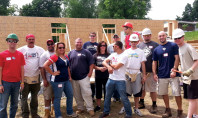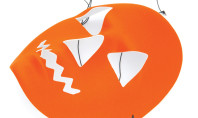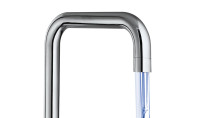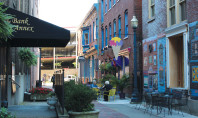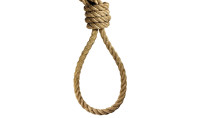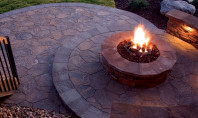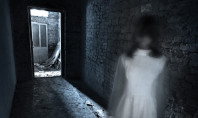Our Covered Bridges

by Mary Beth Schwartz
Seven historic covered bridges are situated in the beautiful landscape of the Lehigh Valley
Thousands of people travel to the Lehigh Valley annually. Some come for the great shopping. Others love antiquing. Foodies crave the cuisine from top restaurants. And then there are the history buffs known as Bridgers – covered bridge enthusiasts who travel here to visit the crossings of yesteryear.
“There were originally 35 covered bridges built in Lehigh County, all of which were authentic covered bridges. In Northampton County, there were 28 covered bridges built. We refer to them as lost bridges because they are no longer standing,” says Author Benjamin D. Evans. The Website lostbridges.org lists and documents every known covered bridge that ever existed in North America. The National Society for the Preservation of Covered Bridges offers a guide that features every covered bridge in the world.
When you walk through a covered bridge it is like stepping back in time. And then, you just marvel at the construction of these crossings.
Coopersburg resident Evans has written Pennsylvania’s Covered Bridges: A Complete Guide (University of Pittsburgh Press), as well as New England’s Covered Bridges: A Complete Guide (University Press of New England). According to Evans, seven single-span covered bridges remain in the Lehigh Valley. These bridges can be toured through Discover Lehigh Valley’s brochure, Covered Bridges of Lehigh Valley (Covered Bridge Tour). The self-guided, 50-mile tour can be downloaded and printed from their Website, www.discoverlehighvalley.com.
First on the tour is Bogert’s Covered Bridge. According to the tour brochure, the bridge dates back to the mid-1700s when the Bogert family moved into a log cabin next to the future site of the bridge. The original structure, which spans the Little Lehigh Creek, was built in 1841 with cross planks in the Burr arch truss. It was structurally damaged in 1956. The bridge was saved from demolition from local residents, and closed to vehicular traffic. Today it is open to strictly pedestrian traffic. Owned by the City of Allentown, it is perfect for quiet recreation and is an historic attraction in Allentown’s Lehigh Parkway.
Next stop on the tour is the Manasses Guth Covered Bridge. Owned by Lehigh County, this bridge crosses over Jordan Creek. According to the tour brochure, the original bridge that was built in 1858 was partially destroyed by fire. It was rebuilt in 1882. The Burr truss bridge is named after Manasses Guth, who lived in the adjacent stone farmhouse and was a relative of the first area settler Lorentz Guth. This covered bridge is located at the eastern edge of Covered Bridge Park.
Bridge number three is Wehr’s Covered Bridge. Built in 1841, it is owned by Lehigh County. According to the tour brochure, it is located on the western end of Covered Bridge Park, where it crosses over the Jordan Creek. “In 1862, Ephraim Sieger built a stone gristmill on the north bank of the Jordan, and the bridge became known as Sieger’s Covered Bridge. After several owners, the mill was sold to William Wehr, and the bridge eventually was named Wehr’s Covered Bridge. The present concrete dam near the bridge that supplied power for the gristmill was built in 1904 and replaced the original wooden dam located a short distance upstream. The mill was torn down in 1951, and today locals refer to the general area surrounding the bridge as Wehr’s Dam.”
Stop four on the bridge tour is Rex’s Covered Bridge. Built in 1858, the Burr truss bridge is owned by Lehigh County. It is named after the Rex family, local landowners near the bridge.
After Rex’s, visitors will discover bridge number five, Geiger’s Covered Bridge. “Geiger’s is the only bridge in Pennsylvania that has a stepped portal. Instead of a peaked roof portal, it has a stepped portal like an old town country store,” Evans says. Owned by Lehigh County, the Burr truss bridge was built in 1860. It is located on the eastern side of the Lehigh Valley Zoo. According to the tour brochure, the bridge’s name may have been taken from the family of Jacob Geiger, who settled in the area after immigrating from Germany in the 1700s.
Bridge number six is Schlicher’s Covered Bridge. Owned by PennDOT, the Burr truss bridge is surrounded by the Lehigh Valley Zoo in Lehigh County. Built in 1882, the “deer pen bridge” crosses Jordan Creek. “Schlicher’s is not open to traffic. It is badly in need of repair. There is a sag in the middle of the bridge. It is anticipated that it will be completely disassembled then rebuilt,” Evans says.
Last on the tour is Northampton County’s only covered bridge, the Kreidersville Covered Bridge. Owned by Allen Township, bridge number seven was built in 1839 and only is open to pedestrian traffic. According to the tour brochure, the Burr truss bridge is the oldest covered bridge in the Lehigh Valley and one of the oldest in Pennsylvania. It also has been known as Solt’s Bridge. The bridge crosses over the Hokendauqua Creek. Local residents saved the bridge from demolition in 1959. In 1988, the Kreidersville Covered Bridge Association was founded to help preserve the bridge.
According to Kreidersville Covered Bridge Association Secretary Sue Irons, the bridge used to be the only way to go north from Northampton to Pennsville. “We are the only covered bridge in Northampton County. There used to be two other covered bridges in Allen Township. Both were destroyed – one with fire, one that was torn down from disrepair. Our bridge does not have any steel reinforcement under it. It has the original wood planks. It is in excellent condition. Our little park area around it makes for nice surroundings. It is blocked off for cars – bicycles and people can walk through,” Irons says.
The Kreidersville Covered Bridge Association holds events every year at the bridge. In December there will be a Christmas tree lighting that includes Christmas caroling, a visit from Santa Claus, hot cocoa and cookies. In June 2014 there will be the Kreidersville Covered Bridge Festival. With the festival, there will be a 5K and a 10K race the Sunday of the festival. For information on these events, or becoming a member, visit kreidersvillecoveredbridge.org.
Another important association to Lehigh Valley covered bridges is the Theodore Burr Covered Bridge Society of Pennsylvania (tbcbspa.com). Its purpose is to promote interest and active participation in the preservation and restoration of the remaining historic covered bridges in the Commonwealth of Pennsylvania. Each year the Governor signs a proclamation to encourage all Pennsylvanians to visit covered bridges.
According to Fred J. Moll, Historian of the Theodore Burr Covered Bridge Society of Pennsylvania, and author of Images of America: Pennsylvania’s Covered Bridges (Arcadia Publishing), Pennsylvania has 210 covered bridges, more than any other state. “At one time the state had at least 1,526… The United States had 12,000. Every couple of months we find bridges that we did not know existed through interviews, old newspapers, attic discoveries. Some were removed from modern progress, some burned down by accident or vandalism, some by floods. When you walk through a covered bridge it is like stepping back in time. And then, you just marvel at the construction of these crossings,” Moll says.
Moll told of some of the Lehigh Valley’s bigger lost bridges. “The Portland-Columbia Covered Bridge was built over the Delaware River between Portland, Northampton County, Pennsylvania, and Columbia, Warren County, New Jersey. This 1869 four-span Burr truss crossing was over 700 feet in length. It was originally a toll bridge until it was bought by the county and made toll free in 1927. In later years, the covered bridge became known as the “Coke Bridge.” An advertisement was painted on the entire side of it stating “5 cents sold everywhere 5 cents Coca-Cola.” A flood destroyed the covered bridge in 1955.”
“The Easton-Phillipsburg Covered Bridge opened to traffic on October 14, 1806. Prior to the bridge, ferry service at this location began in 1739. The three-span, 550-foot-long design crossed the Delaware River and connected Easton, Pennsylvania to Phillipsburg, New Jersey. House-like windows adorned the bridge. A notice on the portal of the bridge read, “CAUTION, Keep to the right. All persons keep to the right and walk only.” There were tracks going into the bridge, which was first used for horse-drawn streetcars and later by trolley cars. The covered bridge was replaced in 1895,” Moll says.
“Over the years, covered bridges have been saved by either rebuilding them, reinforcing them, bypassing them, relocating them, or by placing safety devices on them, such as surveillance cameras, nighttime lights, sprinkler systems and fire retardant-treated wood. Also, fines for causing damage to these bridges have been increased to deter acts of vandalism,” Moll says.
“Historically speaking, covered bridges have been an important link in America’s transportation system. Do not let covered bridges become a vanishing icon. It is up to all of us to preserve our covered bridges for future generations to enjoy,” Moll says.


